
views
Getting Ready to Plant
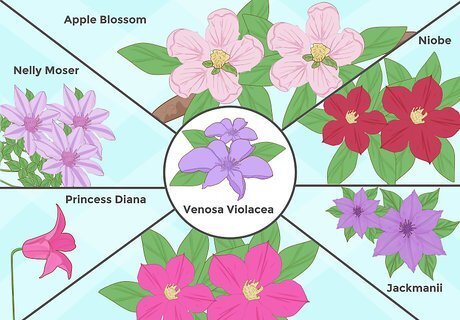
Pick a clematis cultivar. Clematis flowers come in an enormous range of shapes and colors, from pink blooms that span 6 inches across to drooping blue bells to starry white flowers. They've grown in popularity in recent years, so many nurseries offer dozens of varieties to choose from. When you decide which cultivar to buy, take the color, shape, potential shade and sun requirements into account. Clematis often take several years to flower, so look for a potted plant that has an established root system, visible at the drainage holes. Here are the most common clematis cultivars: Nelly Moser: Has large, pink flowers and is one of the most common types of clematis. It's hardy and easy to establish. Ernest Markham: Has stunning magenta flowers and grows vigorously on trellises and arbors. This variety blooms last, from late spring to fall. Niobe: Has red flowers and is a suitable choice for growing in a pot, since it doesn't get very large. Princess Diana: Has pale pink, bell-shaped flowers and does particularly well in very hot climates. Jackmanii: Has deep purple blooms and grows vigorously; a widely available favorite. Venosa Violacea: Has abundant blue-violet blooms and vines that climb vigorously. Apple Blossom: Has small white blooms; grows as an evergreen.
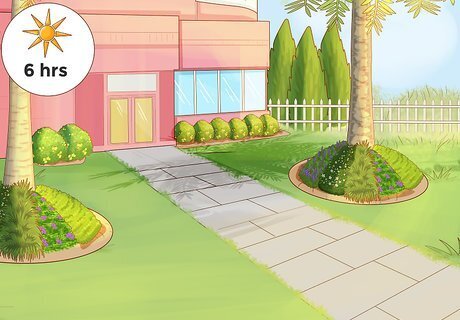
Choose a sunny location. Clematis may come in an amazing range of shapes and sizes, but they have similar needs when it comes to sun and temperature. They are hardy plants that require at least 6 hours of full sun per day. Clematis are hardy from growing zone 3 to zone 9. A few varieties of clematis will grow in partial shade. This varies by variety, but large-flowered clematis may not reach their full potential unless they have full sun for 4 hours per day. Look for a spot with low-growing perennials and groundcover that will shade the roots of the clematis but allow it to grow into full sun about 12 inches above the ground. Large-flowered clematis prefer cool roots and full sun on the vine and flowers. If you can't find a spot with groundcover, add the groundcover later or mulch 4 in (10.2 cm) deep around the clematis to keep the roots cool. You can also plant clematis near the base of a shrub or small tree. The clematis will grow up the branches without harming the "companion" shrub or tree.
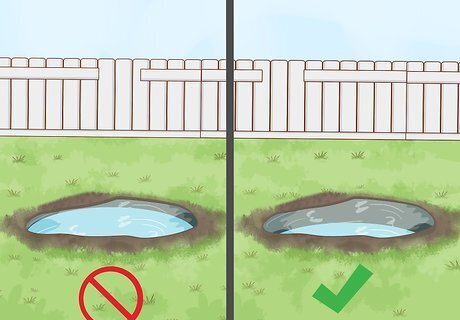
Choose a spot with well-draining soil. The location shouldn't be so dry that it doesn't retain moisture, but it should drain well enough that standing water doesn't sit around the roots of the clematis. To test whether the soil in an area drains well, dig a hole and fill it with water. If the water drains immediately, the soil is on the sandy side. If the water stands in the hole, the soil has too much clay, and doesn't drain fast enough. If the water slowly but steadily seeps into the soil, it's just right for clematis.
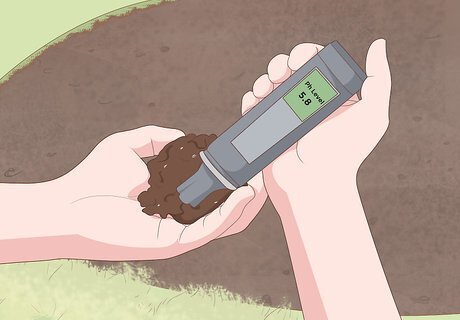
Test the soil for its pH level. Clematis prefer the soil to be neutral or alkaline over acidic, but many adapt to lightly acidic soils (6.5-6.8) If you conduct a test and determine that the pH is a little too acidic, sweeten the soil by mixing in limestone or wood ash.
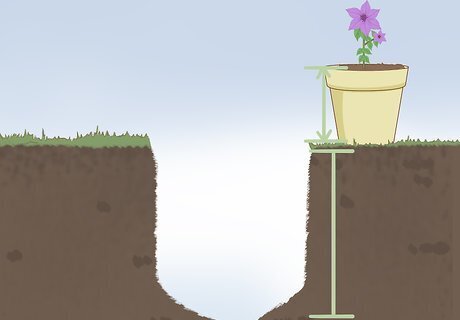
Dig a hole and enrich the soil. Dig a hole several inches deeper than the pot the clematis came in, so that when you plant it the soil comes right up to the first set of leaves. Before you plant the clematis, amend the soil by working in compost and granular organic fertilizer. This will ensure that the plant has enough nutrients to establish itself in the first few months after planting. If you're working with soil that tends to be clay heavy (slow to drain), dig the hole a few inches deeper than you normally would. If your soil is sandy (quick to drain), a slightly shallower hole will be better for the plant's roots, so they're close enough to the surface to get plenty of water.
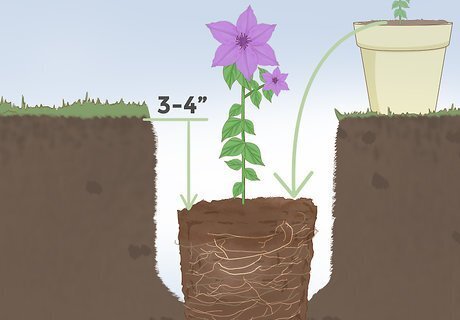
Prune the clematis. It helps reduce transplant shock by pruning a clematis by about 1/3 its length as you find it at the time of purchase. If the plant is blooming, enjoy the blooms before planting, and then prune and plant. No matter how careful you are in planting, you will damage some feeder roots benefiting the vines and leaves. A 1/3 pruning helps relieve this stress by giving damaged roots less vine to support at planting time. Very gently remove the clematis from the pot it came in, taking care not to rip or break the fragile roots and shoots, but know that some damage is likely. Set the root ball into the hole, and for large flowered clematis only, place about 3-5 in (7.6-12.7 cm) below the surface of the dirt, and pat the soil around its base stem. The soil should come up to the first set of leaves; if it doesn't, lift out the root ball and dig the hole a bit deeper. Leave the stake in place so that the young clematis has something to grow against for the first year.

Mulch around the roots. Place 4 inches of composted organic mulch around the base of the clematis to keep the roots cool. Do not use straw or raw bark mulch, since these with soak up nitrogen as they decay, robbing your clematis. You can also plant or encourage the growth of low-growing perennials whose leaves will shade the roots of the clematis throughout the summer.
Caring for Clematis
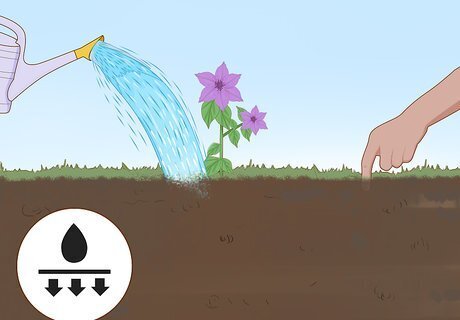
Keep clematis well watered. Give the clematis long, deep drinks of water whenever the soil seems dry. To test whether it is dry, stick your finger in the soil, then pull it out. If you didn't hit wet soil, it's time to water the clematis. Don't water the clematis too often, though; since the roots are shaded, water may tend to sit for a longer period of time before it evaporates. Water in the morning, rather than in the evening, so that the water has time to dry and be absorbed before night falls.

Provide a support for the clematis. Clematis will become ground covers unless they have a vertical structure to climb. During the first year, the support that came with the clematis will be sufficient for the plant's needs, but after that you'll need to provide a larger support, like a trellis or arbor, to encourage it to grow bigger. There are, however, clematis that do not climb and are herbaceous perennials. Clematis grows by twisting its leaf stems around slender supports like twine, fishing line, thin branches, or wire grids. Be sure the support you provide isn't too wide for the leaf stems to reach around. It should be less than .5 inches (1.27 centimeters) in diameter. If you have a trellis or arbor made with wide pieces of wood, line it with a wire grid or attach some fishing line to provide a support thin enough for the clematis to wrap around. As the clematis grows larger and reaches around the support, you can help it stay in place by "trussing" it: loosely tying it to the structure with fishing. line.
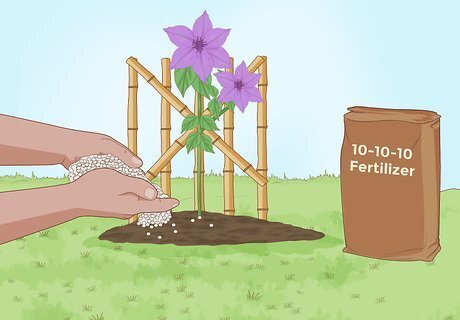
Fertilize the clematis. Every 4 to 6 weeks, from April to September in most climates. Feed the clematis with 4-6-2 fertilizer (called rose and flower food) or side dress it with compost by spreading it around the plant's base. Clematis require plenty of nutrients to grow strong and produce abundant flowers.
Pruning Clematis
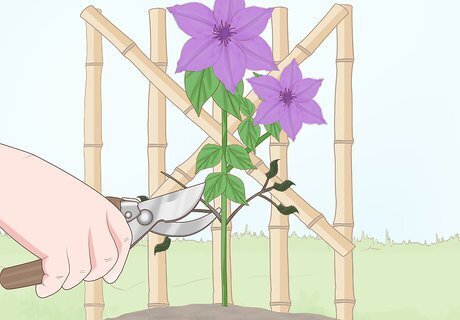
Prune dead or damaged stems at any time. While clematis aren't prone to being affected by pests, large flowered clematis can get a fungal disease that can cause the entire plant to turn black and die. If you see a dead or wilting stem on the clematis, use a clean pair of pruning shears to trim it away at the base. As you prune, look for slug damage or a break that may have caused the stem to collapse. Disinfect the shears in an isopropyl alcohol or a bleach solution between cuts so you don't spread the disease to other parts of the plant.
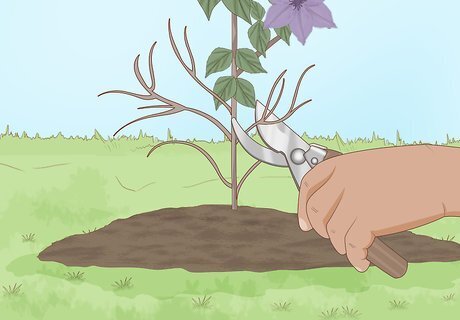
Prune away the oldest stems. Since flowering becomes less abundant on stems over 4 years old, you can cut off the oldest stems to encourage new ones to grow. Wait until after the first bloom of the season, then use a pair of clean pruning shears to remove the stems at the base stem.

Perform annual pruning according to the cultivar's requirements, knowing that bloom time will be manipulated by when and how much you prune, anywhere from deadheading (only taking off spent flowers) to a hard prune (taking the plant back to 12" tall or less). Some clematis does well with an annual pruning to encourage fresh growth. However, different cultivars may be pruned at different times of year. It's important to decide when to prune your specific cultivar, based on what flowering partners it is near, and some clematis only flower in spring with no repeat. You might be removing flower-producing stems if you prune at the wrong time of year. Plants that bloom on old wood, meaning the flowers appear on last year's stems, require no pruning except to remove anything that has died; control their size a bit and keep them contained. After they flower, prune back to a pair of healthy buds. ('Apple Blossom' should be pruned to whatever degree you think necessary immediately after it finishes flowering. Late summer pruning of evergreen clematis like this will remove next year's flowering wood, and stimulate new growth that will freeze in the winter, greatly weakening the whole plant.) Plants that bloom first on old wood and again on new wood, meaning the flowers appear on last year's stems and new spring stems, may be pruned as needed, anytime. Prune in early spring, before they bloom, to remove weak stems, or hard prune to produce later flowers if that is what you would prefer, then again after they bloom to encourage rebloom and keep the growth under control. (Nelly Moser, Niobe, and Ernest Markham are in this group.) Plants that bloom on new wood, meaning the flowers appear only on new spring stems, should be cut back to 12 inches at the beginning of spring. (This includes Princess Diana, Jackmanii, and Venosa Violacea.)

















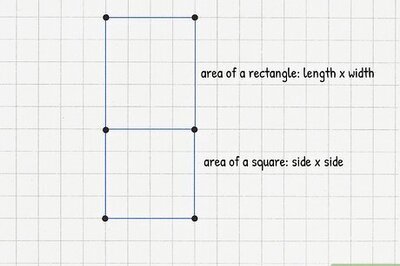
Comments
0 comment